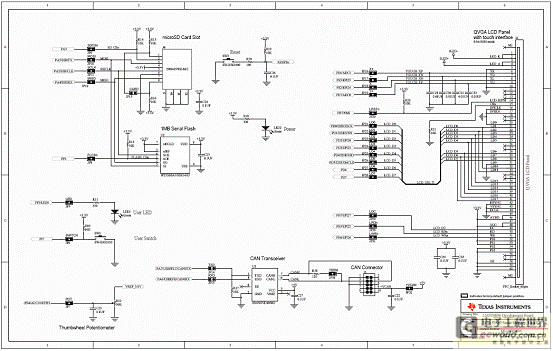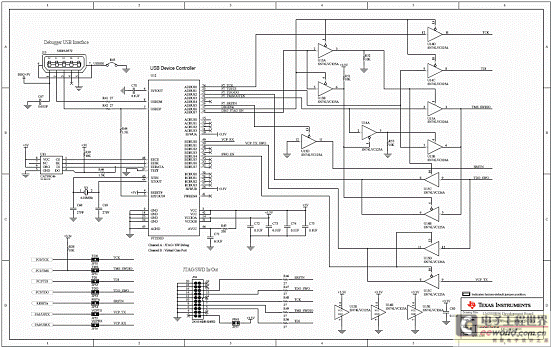德州仪器(TI)公司Stellaris?所提供一系列的微控制器是首款基于ARM? CortexTM-M3的控制器,它们为对成本尤其敏感的嵌入式微控制器应用方案带来了高性能的32位运算能力。这些具备领先技术的芯片使用户能够以传统的8位和16位器件的价位来享受32位的性能,而且所有型号都是以小占位面积的封装形式提供。
LM3S9B96微控制器的优势还在于能够方便的运用多种ARM的开发工具和片上系统(SoC)的底层IP应用方案,以及广大的用户群体。另外,该微控制器使用了兼容ARM Thumb?的Thumb2指令集来减少存储容量的需求,并以此达到降低成本的目的。最后,LM3S9B96微控制器与Stellaris?系列的所有成员是代码兼容的,这为用户提供了灵活性,能够适应各种精确的需求。
为了能够帮助用户产品快速的上市,德州仪器(TI)公司提供了一整套的解决方案,包括评估和开发板、白皮书和应用笔记、方便使用的外设驱动程序库、以及强大的支持、销售和分销商网络。
LM3S9B96目标应用:
The Stellaris family is positioned for cost-conscious applications requiring significant control processing and connectivity capabilities such as:
Remote monitoring
Electronic point-of-sale (POS) machines
Test and measurement equipment
Network appliances and switches
Factory automation
HVAC and building control
Gaming equipment
Motion control
Medical instrumentation
Fire and security
Power and energy
Transportation

图1.Stellaris LM3S9B96方框图

图2.Stellaris LM3S9B96 Cortex-M3处理器方框图
Stellaris? LM3S9B96开发板
The Stellaris? LM3S9B96 Development Board provides a platform for developing systems around the advanced capabilities of the LM3S9B96 ARM? Cortex?-M3-based microcontroller.
The LM3S9B96 is a member of the Stellaris Tempest-class microcontroller family. Tempest-class devices include capabilities such as 80 MHz clock speeds, an External Peripheral Interface (EPI) and Audio I2S interfaces. In addition to new hardware to support these features, the DK-LM3S9B96 board includes a rich set of peripherals found on other Stellaris boards.
The development board includes an on-board in-circuit debug interface (ICDI) that supports both JTAG and SWD debugging. A standard ARM 20-pin debug header supports an array of debugging solutions.
The Stellaris? LM3S9B96 Development Kit accelerates development of Tempest-class microcontrollers. The kit also includes extensive example applications and complete source code.
LM3S9B96开发板主要特性:
The Stellaris? LM3S9B96 Development Board includes the following features.
Simple set-up—USB cable provides debugging, communication, and power
Flexible development platform with a wide range of peripherals
Color LCD graphics display
– TFT LCD module with 320 x 240 resolution
– Resistive touch interface
80 MHz LM3S9B96 microcontroller with 256 K Flash, 96 K SRAM, and integrated Ethernet MAC+PHY, USB OTG, and CAN communications
– – 8 MB SDRAM (plug-in EPI option board)
– – EPI break-out board (plug-in option board)
1 MB serial Flash memory
Precision 3.00 V voltage reference
SAFERTOS? operating system in microcontroller ROM
I2S stereo audio codec
– Line In/Out
– Headphone Out
– Microphone In
Controller Area Network (CAN) Interface
10/100 BaseT Ethernet
USB On-The-Go (OTG) Connector
– Device, Host, and OTG modes
User LED and push button
Thumbwheel potentiometer (can be used for menu navigation)
MicroSD card slot
Supports a range of debugging options
– Integrated In-circuit Debug Interface (ICDI)
– JTAG, SWD, and SWO all supported
– Standard ARM? 20-pin JTAG debug connector
USB Virtual COM Port
Jumper shunts to conveniently reallocate I/O resources
Develop using tools supporting Keil? RealView? Microcontroller Development Kit (MDK-ARM), IAR Embedded Workbench, Code Sourcery GCC development tools, Code Red Technologies development tools, or Texas Instruments’ Code Composer Studio? IDE
Supported by StellarisWare? software including the graphics library, the USB library, and the peripheral driver library
An optional Flash and SRAM memory expansion board (DK-LM3S9B96-EXP-FS8) is also available for use with the DK-LM3S9B96 development board
– Works with the External Peripheral Interface (EPI) of the Stellaris microcontroller
– Provides Flash memory, SRAM, and an improved performance LCD interface
LM3S9B96开发板包括:
The Stellaris? LM3S9B96 Development Kit contains everything needed to develop and run a range of applications using Stellaris microcontrollers:
LM3S9B96 development board
8 MB SDRAM expansion board
EPI signal breakout board
Retractable Ethernet cable
USB Mini-B cable for debugger use
USB Micro-B cable for OTG-to-PC connection
USB Micro-A to USB A adapter for USB Host
USB Flash memory stick
microSD Card
20-position ribbon cable
CD containing:
– A supported version of one of the following (including a toolchain-specific Quickstart
guide):
Keil? RealView? Microcontroller Development Kit (MDK-ARM)
IAR Embedded Workbench
Code Sourcery GCC development tools
Code Red Technologies development tools
Texas Instruments’ Code Composer Studio? IDE
– Complete documentation
– Quickstart application source code
– Stellaris? Firmware Development Package with example source code

图3.LM3S9B96开发板外形图
图4.DK-LM3S9B96开发板方框图

图5.DK-LM3S9B96开发板电路图(1)

图6.DK-LM3S9B96开发板电路图(2)

图7.DK-LM3S9B96开发板电路图(3)

图8.DK-LM3S9B96开发板电路图(4)

图9.DK-LM3S9B96开发板电路图(5)

图10.DK-LM3S9B96开发板电路图(6)

图11.用于DK-LM3S9B96的FLASH/SRAM/LCD IF扩展板电路图(1)

图12.用于DK-LM3S9B96的FLASH/SRAM/LCD IF扩展板电路图(2)
上一篇:研究32位Cortex-M3 MCU开发技术
下一篇:研究32位Cortex-M3 MCU开发技术
- 热门资源推荐
- 热门放大器推荐
- 宁德时代巧克力换电生态大会将举行,什么是“巧克力换电”?1.5分钟换电能实现吗?
- 新型生物材料与高端医疗器械广东研究院、远诺技术转移中心加入面向初创企业的 MathWorks
- S5PV210 Linux字符驱动之PWM蜂鸣器驱动
- 尼得科机床新增可实现高效加工的高速主轴产品线
- Gartner发布2025年影响基础设施和运营的重要趋势
- 智谱清言英特尔酷睿Ultra专享版发布,离线模型玩转AIPC
- Bourns推出全新高效能、超紧凑型气体放电管 (GDT) 浪涌保护解决方案
- S5PV210之UBOOT-2011.06启动过程解析
- 六个理由告诉您为什么应该将模拟无线麦克风更换为数字无线麦克风
- S5PV210启动过程分析

 Verilog HDL数字集成电路设计原理与应用
Verilog HDL数字集成电路设计原理与应用 LM139AJ/NOPB
LM139AJ/NOPB










 京公网安备 11010802033920号
京公网安备 11010802033920号